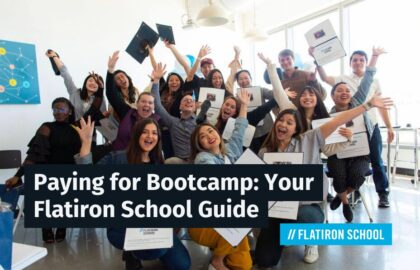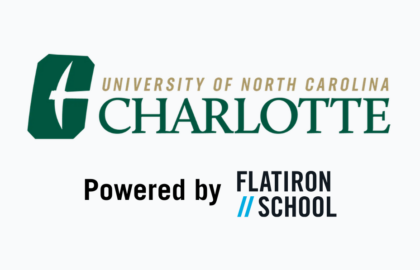As the oldest operating coding bootcamp, we’re proud to be responsible for a lot of firsts in our industry.
-
In 2012, we were the first to create open-sourced, comprehensive pre-work to allow more people to get started learning for free.
-
In 2013, we became the first bootcamp to partner with the government (the City of New York) to increase access among underrepresented groups in tech.
-
In 2014, we pioneered the idea of transparency in education by releasing the first- ever, independently verified jobs report, which later became the standard embraced at the White House TechHire Initiative launched under President Obama.
-
In 2016, we were the first bootcamp to launch a flexible, online program on our own proprietary platform designed to enable real-world, community-driven learning remotely, without compromising our commitment to outcomes.
After the past year, organizations are realizing that employees can be happier, and more effective, if they’re given the flexibility and autonomy to work where they want, when they want. Yet most of higher education is counting the days before things can go back to exactly how they’ve always been done.
At Flatiron School, we’ve never been a fan of doing things “how they’ve always been done” – especially in education. The system is a mess in large part because of “bundling.” Think lectures, research, dining, gyms, housing, etc… If a traditional college student wants to learn accounting, their tuition dollars are also going to support everything from lacrosse to art history, to ivy-covered libraries.
Part of Flatiron's original value proposition is that we unbundled all of that stuff. We give students exactly what they need to launch and grow in a career they can be passionate about — nothing more, nothing less. It's that intense focus that has allowed us to achieve incredible outcomes, and do so in a dramatically more cost-effective way. Today, we’re excited to announce new programs and formats that will be a leap forward in increasing access to outcomes-oriented education. Here’s how we’re doing it:
1. Unbundling Format from Location – When online education came about, it promised to increase access to education to a dramatically underserved audience. People with jobs, or families, or who lived out of commuting distance from campuses — could now all have access to education through the internet. Unfortunately, while access increased, students who needed the support and structure of an all-day class were still left behind. People had a choice: either enroll in a full-time program on campus, or try one of the variety of flexible options online.
We’re changing that.
Now, students will no longer choose between campus or online. They’ll only choose between a synchronous (AKA Live) program or asynchronous (AKA Flex) program. Regardless of their choice, students will be able to complete those programs entirely online, entirely on campus, or both. In doing so, we’ll allow students the opportunity to learn the way that suits them best, whether they want a structured, campus-like experience, but done entirely remotely, or an unstructured, flexible program, but with the benefit of a local campus community. Learn more about the launch of Live and Flex.
2. Unbundling Lecture from Support – At Flatiron School, we’ve always put teaching at the center of the educational experience. We use technology to empower teachers, not replace them, and we believe that the idea of “learning from practitioners,” while great as a marketing gimmick, is meaningless if those practitioners aren’t passionate and engaged teachers.
Before COVID-19, we might have had 10 different instructors giving the same lecture, on the same day, at the same time, in 10 different classrooms at our various campuses and online. Those same lecturers would then lead their individual cohorts through lab assignments, study groups, projects, etc… Over the past year though, it’s become increasingly clear that being a great lecturer is an entirely different skill set than being great at helping students 1:1 or in small groups.
As part of our new Live and Flex formats, we will be centralizing all lectures and making them available to any student across all programs and locations. This creates a few meaningful benefits for students.
First, students will all have access to the best lecturers regardless of which program they enroll in or whether they attend campus or not. This also applies to our guest speakers, whose talks will be available to all students whether they’re remote or sitting at any one of our campuses.
Second, because we’ll be streaming all lectures, students can attend any lecture they want, at any time, either live or on demand, as fits their schedule. And finally, by centralizing lectures, we are able to dramatically increase our capacity for directly helping students with individualized support. Instead of 10 teachers giving the same lecture, two might be giving different versions while eight host study groups, interactive review sessions, or 1:1’s.
3. Unbundling Cohorts from Community – The cohort experience at Flatiron School is incredibly powerful. Even today, students from our original cohorts maintain deep friendships. But as we’ve grown, students are saying they want even more. They want to build bonds with people outside of their cohorts. For example, Software Engineering students ask to work with Data Science students. Students learning online have asked to build relationships with students on campus. Students in Seattle want to collaborate with students in New York.
Working entirely remotely over the past year, we were forced to change the way we think about community entirely, and through that saw different kinds of communities emerge.
Students assembled around not just geographies but professional interests. And hobbies. And even identities to support each other through challenging times. As powerful as the connections are within cohorts, it’s clear that the tightest bonds form around shared values.
While we continue to believe in the value of cohorts, going forward, our campuses will be designed to foster communities in new ways. Students will join distributed cohorts, while meeting on campus to form local communities across disciplines, cohorts, and modalities. All students, regardless of program, will have access to campus as little or as often as they want, where the primary purpose will be to connect to other students, build their networks and engage with the local tech community through our ongoing events, meetups, and speaker series.
We’ve learned a lot over the last year, and we’re not going back to things “exactly how they’ve always been done.” This year, we’ve forever changed the way we work. And we’re excited to prepare students for this new world of work by changing the way we learn.



